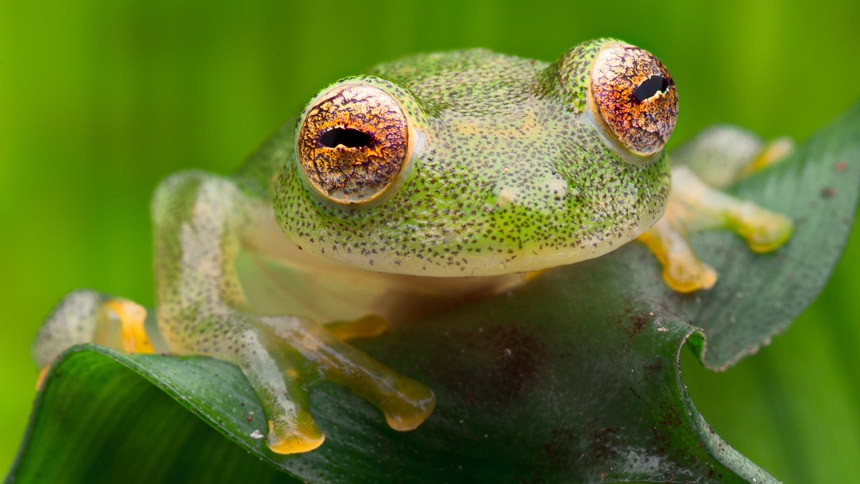
What is a Frog?
Frogs are not a single species, but rather a diverse grouping of animals that, while being similar in many ways also differ greatly in others. We all know that frogs have superior jumping abilities, possess a fantastically long tongue, and make excellent and exciting pets, but what else?
That’s what will be explained here, as hopefully by looking at both the technical and physical side of frogs, any and all questions you may have will be answered. Questions like: What do scientists consider a frog? Are they different from toads? And why does it look the way it does?
Page Contents
The Scientific Classification of Frogs
All living creatures fall into a unique place on a vast web that scientists have created to show the evolutionary relationships of all life forms (also known as their “phylogeny”).
The scientific practice of this is called “taxonomy,” and it is an excellent tool to help understand where things fit in this vast world of ours. In taxonomy, living things are classified by increasingly smaller categories that highlight distinct qualities of the creature – whether they be physical or lifestyle differences.
The first distinction made is the most general, and it’s called the life form’s “Domain.” In descending order of most general to least, next up is Kingdom, then Phylum, Class, Order, Family, Genus, and finally Species.
So where do frogs fit on here, and what does that tell us about them? Well first and foremost, frogs are “eukaryotes,” which is the domain that all animals, plants, fungi, and essentially all life apart from bacteria fall into. The Domain qualifies and describes the cells of the organisms, but doesn’t provide much else.
Their kingdom is also an easy one, as they fall into the “animalia” kingdom. Essentially, this just means that they aren’t plants or fungi (with technical classifications, of course). Next up is their Phylum, and here is where things start to get a bit specific.
Frogs are in the Phylum Chordata, which essentially separates the vertebrates from the invertebrates. Fishes, amphibians, birds, reptiles, and mammals all are found in this Phylum. The creatures that aren’t in Chordata (which is about 90% of *all animals*!) include insects, spiders, snails, worms, and many other invertebrates.
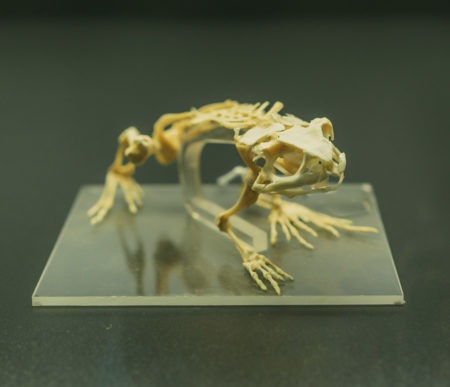
So far, all we can deduce from a frog’s phylogeny (that is, their unique taxonomic classifications) is that:
- Frogs are not bacteria
- Frogs are animals
- Frogs are vertebrates
That is actually a lot of specifying information, but given what most people know about frogs, it doesn’t help us much.
The beauty with taxonomy, though, is that each subsequent classification/grouping inherently gets more specific and provides more nuanced information, and for frogs that truly begins when you reach their Class, “Amphibia.” The name “Amphibia” is derived from the Greek meaning “double life,” alluding to these creatures living both in water and on land.
All creatures that exist within the “Amphibia” class are called “amphibians,” and there are a few other specifics that accompany this classification. For example, all amphibians are, at some point, “terrestrial quadrupeds.” This means that they will move around on land with four legs at some point in their life. They also flaunt both gills and lungs, although at different points in their life cycles. Frogs, for example, have gills in their larval stage (as tadpoles), which are then replaced by lungs as they migrate to land. Of course, frogs are not the only creature to be found in the Amphibia Class, as salamanders, toads, and other niche amphibians are described here as well.
Other attributes of amphibians include an inability to regulate body temperature, a limitation to warm, moist climates, and confinement to bodies of freshwater.
The class Amphibia can generally be further broken down into three Orders: Caudata, Apoda, and Anura. Caudata (“tail-bearing”) describes Salamanders; Apoda (“without legs”) describes certain worm-like amphibians; and Anura (“without tail”) describes frogs and “true toads,” and is where our focus will land next.
Frogs are Anuras
Now, while Anura is derived from the Greek meaning “without tail,” that is not the only information it imparts. It also tells us that the organism has “unequal limbs”, usually indicating longer hind legs than forelegs. And it also partially describes the means of fertilization, with all members of the Anura class participating in external fertilization (the eggs are laid first, opposite of, say, chickens). Due to the unequal limb length, these organisms are also often great jumpers.
Of course, keeping in line with how things have been going, this is not the end of the descriptive trail we’ve gone on. Family is next in line after Order, and this is really where things get precise. There are seven of these Families in the Order Anura, and each represents some type of either frog or toad. However, in colloquial speech when someone references a “frog” or a “toad,” there are usually only two Families that are relevant: Family Bufonidae, or “true toads,” and Family Ranidae, or “true frogs.”
Other Families include the Family Hylidae, which boasts tree frogs; the Family Ascaphidae which has the only tailed frog; and the Family Pelobatidae, which includes the narrow-toed toads (the narrow-toads). There are a few other Families, and at this point, we can see that the differences between them are much more specific than the differences we were seeing between Orders or Classes.
Frogs vs Toads
This begs an important question that most of us have pondered at one point or another: What is the difference between a frog and a toad? So far, we know the similarities between the two: they are both not bacteria, they both are animals and have spines, they both are amphibians, and they both have long hind legs, no tail, and fertilize externally.
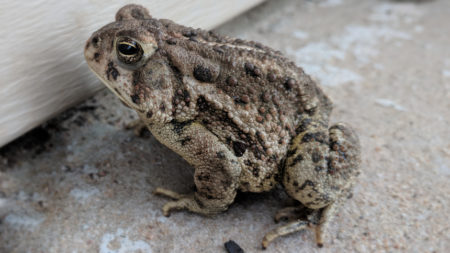
While that does tell us a lot, we can still get more specific by comparing their relative Families against each other. For general purposes, we will look solely at the “true” toads and frogs.
Specifically, we will look at how members of Family Ranidae, the true “frogs,” compare to members of Family Bufonidae, the true “toads.” It is also important to note that technically toads are but a subset of frogs, which means that all toads are frogs but not all frogs are toads!
The most notable and perhaps greatest difference between the two are their habitats. Because a frog’s sleek, damp skin requires consistent moisturization, they hunker down in areas with a quick and constant source of water. This is contrasted with toads of course, who aren’t beholden to water in the same way frogs are. They like to settle in the drier environments that their dry, bumpy skin allows for. Toads also have far fewer predators than frogs do, which is again a result of their skin.
While a frog’s skin does very little to deter an assailant, toad’s skin actually has two defense mechanisms: a bitter taste and a repugnant odor. But before you begin thinking that toads are the absolute best when compared to frogs, it is important to note a final distinction. Frogs are essentially superheroes to toads, and the reason lies in their legs.
With the extra length and power that their long hind legs provide, frogs have the ability to quickly escape an attack. And these legs, when coupled with a frog’s slender, aerodynamic body and protrusive all-seeing eyes, make it clear why frogs are the best (especially when compared to the squat, wide-body, and short hind legs of a toad).
Characteristics of a Frog
In this section, we will look at the characteristics of a frog. Their skin, eyes, feet, and legs to be precise.
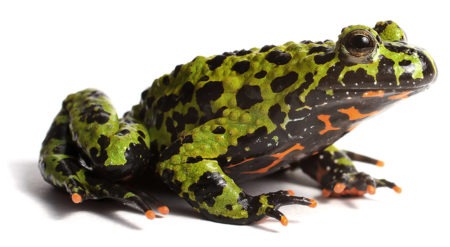
Skin
We saw earlier that it’s necessary for frogs to keep their skin hydrated, and the reason behind this is pretty interesting. First and foremost, frogs don’t drink through their mouths. Instead, they actually absorb any moisture or water directly through the skin; it would be pretty silly to see a frog gulping water as it streams through a pond.
More importantly than that, however, is the main reason frogs must keep their skin moist: it helps them “breathe.” Technically, frogs do have lungs that they use to breathe through their mouth. This sadly isn’t enough for the little amphibians though, so they’ve evolved a way to inject just a little more oxygen into their body, and that’s by absorbing it through their skin.
There was just a small caveat with this evolution, as dry skin proved to be very poor for oxygen absorption. To solve this, frogs adapted the aforementioned moisturization to keep things running swimmingly. They don’t just rub a little bit of water on themselves and call it a day, though. Instead, their skin actually contains glands (they have what is called “glandular skin”) that produce a mucous-like layer, which both prevents them from drying out and facilitates oxygen absorption!
But with every advantage comes a disadvantage, and frogs are no exception. Their skin is an excellent organ that has a variety of necessary functions, and it is due to this that it is also remarkably fragile. Riddled with holes and pores that help water and oxygen move across the membrane, their light, breathable skin can’t do too much to resist a predator once it latches on. About once a week, assuming it doesn’t get eaten, a frog will shed, and oftentimes eat, its own skin.
Eyes
A frog’s eyes are one of its most noticeable features. These bulging, protrusive eyes may seem like an abnormality, but they actually share features with most eyes of prey and have very specific functions. If you pay attention to the eyes of any prey – from rabbits to giraffes, — you will notice that their eyes rest on the sides of their head, while predatory animals (bears, lions) have eyes facing forwards.
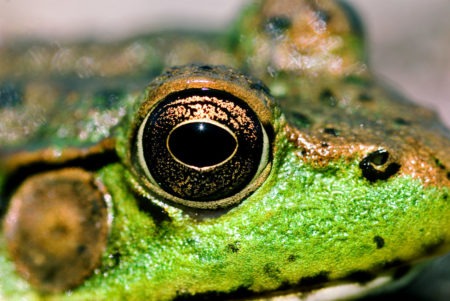
This is due to the differing functions that these animals require; whereas predators are looking to focus on the prey directly ahead of them (whether in a chase or a prowl), animals of prey are constantly looking around them for a predator, or, if it’s too late for that, an escape.
Frogs are no exception to this. In fact, if anything, they’re a great exemplar. Their protrusive eyes allow frogs to see nearly 180 degrees around them: showing them what’s in front of them, as well as to both sides, simultaneously.
Their eyes also help out in a few other ways. To start with a weird one, when a frog swallows it actually pulls its eyes into its mouth to help shove the food into its stomach. This is why, if you’ve ever seen a frog catch a fly, it closes its eyes as it eats it. Besides this, frogs eyes also allow for enhanced underwater vision by lowering a third, transparent eyelid, and they allow for excellent night vision.
Feet and Legs
A frog’s most distinct and memorable non-physical characteristic is surely its jump. Granted, they can catch flies with their incredible tongue, and they do fill the night with eerie croaks, but these both pale in comparison to this great gift that their legs have afforded them.
Many frogs are equipped with long, powerful hind legs that aid them both on land and in water. In fact, some species of land frogs are even able to hop further than ten times their body length. And as for frogs that primarily live in the water, these powerful tools serve as a means for quick aquatic propulsion.
The feet of a frog only further help what their legs do. With four toes in the front, frogs make use of their forefeet in a variety of ways. Some aquatic species, for example, employ them as a way to steer when swimming in the water, which in some cases could be the difference between life and death.
A frog’s hind feet differ from its forefeet, and this difference is greater in some species and more diminished in others. To use aquatic species as an example again, these frogs flaunt webbing between their five-toed feet that significantly enhance their swimming abilities.
Or to look at certain terrestrial species, apart from the obvious function of jumping and leaping these hind legs also help some frogs to dig! This can be for various reasons. One such reason is for hydration.
As was mentioned previously, all “true frogs” need to keep their skin moist and hydrated, but sometimes that simply isn’t feasible due to environmental conditions. In these scenarios, some frogs will bury themselves underground to escape from the heat and acquire some hidden, underground water.
Conclusion
Frogs are no simple animal. They are a complex and variegated grouping of creatures that span the water to land, from dank and humid climates to drier and hotter ones.
Their bodies were equipped for incredible movement and detection, allowing them to avoid most threats by their incredible speeds and control. And while they may be fragile, they are also very resilient as their bodies provide them with the resources to counter threats of predators and the environment. And no doubt these incredible animals will make a great pet and friend for anyone willing.

Leave a Reply